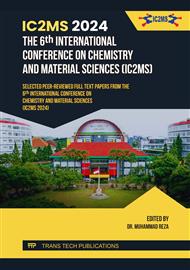[1]
A. Homaei, 'Enzyme Immobilization and its Application in the Food Industry', in Advances in Food Biotechnology, Wiley, 2015, p.145–164.
DOI: 10.1002/9781118864463.ch09
Google Scholar
[2]
N. Ranjbari, M. Razzaghi, R. Fernandez-Lafuente, F. Shojaei, M. Satari, and A. Homaei, 'Improved features of a highly stable protease from Penaeus vannamei by immobilization on glutaraldehyde activated graphene oxide nanosheets', Int J Biol Macromol, vol. 130, p.564–572, Jun. 2019.
DOI: 10.1016/j.ijbiomac.2019.02.163
Google Scholar
[3]
A. Ainezzahira, H. D. Multri, W. El Kiyat, and N. Nacing, 'Review: Pemanfaatan α-Amilase pada Modifikasi Pati Singkong Sebagai Substitusi Gelatin pada Produk Marshsmallow', JURNAL AGROINDUSTRI HALAL, vol. 5, no. 2, p.220–227, Oct. 2019.
DOI: 10.30997/jah.v5i2.1594
Google Scholar
[4]
Y. R. Maghraby, R. M. El-Shabasy, A. H. Ibrahim, and H. M. E.-S. Azzazy, 'Enzyme Immobilization Technologies and Industrial Applications', ACS Omega, vol. 8, no. 6, p.5184–5196, Feb. 2023.
DOI: 10.1021/acsomega.2c07560
Google Scholar
[5]
S. Bahri, A. Homaei, and E. Mosaddegh, 'Zinc sulfide-chitosan hybrid nanoparticles as a robust surface for immobilization of Sillago sihama α-amylase', Colloids Surf B Biointerfaces, vol. 218, p.112754, Oct. 2022.
DOI: 10.1016/j.colsurfb.2022.112754
Google Scholar
[6]
N. Al Indis, 'Potensi Arang Aktif yang Terbuat dari Kulit Biji Nyamplung Sebagai Adsorben Logam Berat Kromium (VI)', Journal Science Innovation and Technology (SINTECH), vol. 2, no. 1, p.35–41, Nov. 2021.
DOI: 10.47701/sintech.v2i1.1579
Google Scholar
[7]
P. González-García, 'Activated carbon from lignocellulosics precursors: A review of the synthesis methods, characterization techniques and applications', Renewable and Sustainable Energy Reviews, vol. 82, p.1393–1414, Feb. 2018.
DOI: 10.1016/j.rser.2017.04.117
Google Scholar
[8]
V. da Silva Lacerda, J. López-Sotelo, A. Correa-Guimarães, and S. Hernández-Navarro, 'Rhodamine B removal with activated carbons obtained from lignocellulosic waste', J Environ Manage, vol. 155, p.67–76, May 2015.
DOI: 10.1016/j.jenvman.2015.03.007
Google Scholar
[9]
M. C. P. Gonçalves, T. G. Kieckbusch, R. F. Perna, J. T. Fujimoto, S. A. V. Morales, and J. P. Romanelli, 'Trends on enzyme immobilization researches based on bibliometric analysis', Process Biochemistry, vol. 76, p.95–110, Jan. 2019.
DOI: 10.1016/j.procbio.2018.09.016
Google Scholar
[10]
S. Hapsari, D. F. Susanto, H. W. Aparamarta, A. Widjaja, and S. Gunawan, 'Separation and Purification of Wax from Nyamplung (<i>Calophyllum inophyllum</i>) Seed Oil', Materials Science Forum, vol. 964, p.1–6, Jul. 2019.
DOI: 10.4028/www.scientific.net/MSF.964.1
Google Scholar
[11]
Y. Yu, J. Yuan, Q. Wang, X. Fan, P. Wang, and L. Cui, 'A promising approach for bio-finishing of cotton using immobilized acid-cellulase', Fibers and Polymers, vol. 15, no. 5, p.932–937, May 2014.
DOI: 10.1007/s12221-014-0932-2
Google Scholar
[12]
V. S. Kumar, S. Meenakshisundaram, and N. Selvakumar, 'Conservation of cellulase enzyme in biopolishing application of cotton fabrics', Journal of the Textile Institute, vol. 99, no. 4, p.339–346, Jul. 2008.
DOI: 10.1080/00405000701476351
Google Scholar
[13]
A. A. Hidayah, Azizah, R. Winarsa, and K. Muzakhar, 'Utilization of coffee pulp as a substrate for pectinase production by Aspergillus sp. VTMS through solid state fermentation', 2020, p.020012.
DOI: 10.1063/5.0030474
Google Scholar
[14]
S. Ubaidillah and K. Muzakhar, 'Sugar-Rich Hydrolyzates from Coffee Pulp Waste which Produced under Solid State Fermentation by Pestalotiosis sp. VM9 and Aspergillus sp. VTM5, and Its Efficiency as Medium for Single Cell Protein Saccharomyces cerevisiae', IOP Conf Ser Mater Sci Eng, vol. 546, no. 6, p.062033, Jun. 2019.
DOI: 10.1088/1757-899X/546/6/062033
Google Scholar
[15]
G. Maciel, 'Activated Carbon from Rice Husk Biochar with High Surface Area', Biointerface Res Appl Chem, vol. 11, no. 3, p.10265–10277, Oct. 2020.
DOI: 10.33263/BRIAC113.1026510277
Google Scholar
[16]
M. Erdem, R. Orhan, M. Şahin, and E. Aydın, 'Preparation and Characterization of a Novel Activated Carbon from Vine Shoots by ZnCl2 Activation and Investigation of Its Rifampicine Removal Capability', Water Air Soil Pollut, vol. 227, no. 7, p.226, Jul. 2016.
DOI: 10.1007/s11270-016-2929-5
Google Scholar
[17]
M. Molina-Sabio and F. Rodrı́guez-Reinoso, 'Role of chemical activation in the development of carbon porosity', Colloids Surf A Physicochem Eng Asp, vol. 241, no. 1–3, p.15–25, Jul. 2004.
DOI: 10.1016/j.colsurfa.2004.04.007
Google Scholar
[18]
O. Ioannidou and A. Zabaniotou, 'Agricultural residues as precursors for activated carbon production—A review', Renewable and Sustainable Energy Reviews, vol. 11, no. 9, p.1966–2005, Dec. 2007.
DOI: 10.1016/j.rser.2006.03.013
Google Scholar
[19]
J. Boyle, 'Lehninger principles of biochemistry (4th ed.): Nelson, D., and Cox, M.', Biochemistry and Molecular Biology Education, vol. 33, no. 1, p.74–75, Jan. 2005.
DOI: 10.1002/bmb.2005.494033010419
Google Scholar
[20]
K. S. Muthuvelu, R. Rajarathinam, R. N. Selvaraj, and V. B. Rajendren, 'A novel method for improving laccase activity by immobilization onto copper ferrite nanoparticles for lignin degradation', Int J Biol Macromol, vol. 152, p.1098–1107, Jun. 2020.
DOI: 10.1016/j.ijbiomac.2019.10.198
Google Scholar
[21]
F. Firdaus, S. Dali, and H. J. Rusman, 'Imobilisasi Enzim Lipase Dedak Padi (Oryza Sativa L.) Pada Karbon Aktif: Karakterisasi, dan Uji Stabilitas Kerja Enzim Imobil', Indo. J. Chem. Res., vol. 5, no. 1, p.32–36, Jul. 2017.
DOI: 10.30598//ijcr.2017.5-fir
Google Scholar
[22]
C. Huang, Y. Feng, G. Patel, X. Xu and J. Qian, 'Production, immobilization and characterization of beta-glucosidase for application in cellulose degradation from a novel Aspergillus versicolor', Int J Biol Macromol, vol. 177, p.437–446, Apr. 2021.
DOI: 10.1016/j.ijbiomac.2021.02.154
Google Scholar


